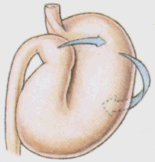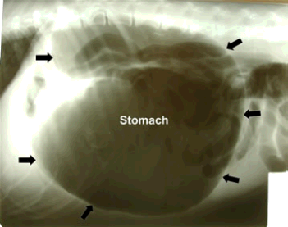I don't know how many of you guys are breeders, but if you are, or if you know someone who is, this post is for you.
There are several different types of reproductive emergencies that I see. The four most common are (in order of most prevalent) - dystocia, eclampsia, pyometra, and mastitis. There are others such as uterine or vaginal prolapse, metritis, mammary tumors, etc, but those are less common.
This post will cover dystocia (slow or difficult labor). It is a fairly in-depth post, as this is a fairly in-depth problem!
There are several important steps that need to be taken during pregnancy that are often overlooked.
First, the bitch should be up to date on her vaccines before she is impregnated. She should also be current on heartworm preventative and flea/tick preventative. I can't tell you how many puppies/kittens I see (and treat) suffering severe flea infestation and/or hookworm infestation leading to life-threatening anemia.
Second, from about the mid-period of pregnancy onward, the bitch should be on a high density food (make sure it is formulated for pregnancy/lactation). Small meals fed frequently will help, as the puppies cause a great deal of press on the stomach/diaphragm, making the stomach (in effect) smaller. A bitch should gain weight, she should NOT lose weight, become thin/emaciated looking, or maintain the same weight.
Deworming at least 3 days in a row with fenbendazole is also crucial. During pregnancy, latent GI parasites (hookworms/roundworms predominantly) come out of muscle hibernation and are passed to the puppies. Thus, careful deworming is essential.
At 45+ days of gestation, xrays should be conducted at your veterinarian so that puppies can be counted. This way, it is easy to tell when the bitch is finished having puppies. It is rarely done by hobby breeders, and it is usually the FIRST thing I do as an ER veterinarian faced with a dystocia.
I see at least one dystocia case a week, and bar none, it is always dogs. Cats very, very, very rarely suffer a dystocia. I have never performed a cat c-section. They are their own species and can actually take days to deliver a whole litter - without any adverse side effects. Dogs, on the other hand, cannot.
Labor proceeds through three phases - stage I labor is exhibited by nesting behavior/hiding, restlessness, and some anxiety. It usually lasts about 12-24 hours. At that time, rectal temperature will usually drop to under 100 degrees. We recommend that people monitor rectal temperature when expecting puppies.
Stage II is active expulsion of the puppy. Normal expulsion with active contractions should take less than 20 minutes. If a bitch is pushing for more than 20 minutes and not producing a puppy, this is a sign of trouble. If anything is noted hanging out (head, feet, etc), and after 20 minutes of CONTINUOUS pushing, nothing comes out; the bitch is having problems. It is normal for a dog (especially with her first litter) to push a bit, then rest, then push some more. 20 minutes of non-stop pushing without a puppy is usually a sign of dystocia.
It is important to note that a dog can go hours between puppies. The bitch may expel a puppy, then sleep for several hours before having another. This is normal. We start to worry if no puppy has been produced beyond 4-5 hours, and at that point, a trip to vet might be in order to check heartbeats via ultrasound.
Stage III is placenta expulsion. Since there are multiple puppies, there are also multiple placentas. They do not come out sequentially - not one puppy/one placenta - it can be three puppies, one placenta, another puppy, 2 more placentas. I also recommend that owners count placentas (the bitch will often eat them, so counting and keeping a close eye on mom is crucial!). Retained placentas are not common in dogs, but they can occur and cause a problem.
If your dog exhibits difficulty, the flow of your ER visit will go something like this: the bitch will be taken to the doctor and examined. A thorough physical exam and cervical exam will be conducted. At that time, the veterinarian will likely recommend checking calcium, blood glucose, and conducting xrays of the abdomen to count puppies.
Once the puppies are counted, an abdominal ultrasound should be conducted to assess fetal heartbeats. They should be at least two times as high as that of mom. If they are slow or absent, a c-section is immediately indicated, as this indicates fetal distress.
If everything looks normal on the xray and ultrasound(i.e. no evidence of fetal death, no puppies blocking the birth canal, puppies look small enough to pass, and heartbeats are normal), the veterinarian will likely offer trying oxytocin. This is a labor-inducing drug (the same that is used in humane females) that stimulates uterine contraction. It is used in very, very small doses intramuscularly to stimulate labor. It was once thought that large doses were appropriate, however recent literature has demonstrated that large doses cause uterine tetany (ineffective contractions) and smaller doses are better. Make sure your veterinarian is aware of this recent research if you are having this problem! Many veterinarians are not and still use whopping doses of oxytocin, which are not indicated, may cause decreased oxygen supply to the puppies, and may make uterine contractions disorganized and ineffective! (Normal doses should be 0.25 units for a small dog, 0.5-1 unit for a medium or large dog). Doses may need to be increased if contractions do not occur.
At the same time the oxytocin is administered, calcium will also likely be given under the skin to help improve uterine contraction.
Usually, I will try oxytocin 3 times. After each shot, the bitch is relegated to a dark, private cage at the back of the ICU with a towel over it. She is left alone for at least 45 minutes. If no puppies are produced after the 3rd shot, I recommend c-section.
There are times when I skip the oxytocin route. It all depends on the owner. Some owners are only concerned about the bitch and do not care if the puppies survive. I will try oxytocin in that case to prevent c-section. In other cases, the owners want the puppies all alive and well. If that is the case, I tell them that c-section is the fastest way to get all the puppies out immediately (though not necessarily alive).
C-section is a risk to the mother and puppies. Pre-anesthetic agents such as opioids can depress fetal oxygen supply, and anesthesia itself is hard on immature body systems. Thus, we avoid this route unless necessary. Unfortunately, it is frequently necessary.
Once the c-section is performed, if there are live puppies, the veterinarian will likely send the bitch home as soon as she is recovered. This is because the puppies have very immature immune systems and are prone to picking up disease. Getting them out of the hospital ASAP is important. If no puppies survived, the bitch will often stay in the hospital for around 24 hours.
Another consideration hobby breeders (and sometimes "professional" breeders) rarely take into account is the myriad number of things that can go wrong and the cost involved if that happens. Breeding well and carefully is an expensive process. The excellent breeders I know rarely make any money off of their pups, despite selling some for around $1000 each. This is because they spend money on appropriate pre-natal care, make sure the pups are appropriately dewormed, vaccinated, and certified in whatever way that particular breed needs to be certified.
A c-section at our hospital runs from $1000-2500 (depending on size of the patient). The majority that I do are small breed dogs (Yorkshire terriers, chihuahuas, and the like). I do get stuck with big dogs sometimes (recently a pit bull and a Boerboel).
It is all too common for me to see a dystocia (or an eclampsia, metritis, mastitis), and the owner whines that they can't afford to pay for it.
My gut reaction (which I rarely voice) is that breeding is expensive. Even if everything goes perfectly, responsible breeding costs money! Most people think they'll just pop out a few, really cute puppies, they'll sell like hotcakes on Craigslist, and they'll make a few bucks.
In reality, "breeders" often get stuck with big medical bills when their pet suffers a dystocia or eclampsia or mastitis. That or they wind up euthanizing an otherwise healthy pet for a totally preventable problem. In addition, I frequently see puppies with parvovirus that the misinformed buyers/owners had been told were vaccinated, only to find out that the breeder administered the vaccines themselves (not to say that responsible, educated breeders can't administer vaccines, they certainly can - but that's not the majority of breeders).
Reproductive emergencies are some of the absolute easiest to prevent by simple spaying/neutering, and yet, they are one of the
MOST common things we deal with in the ER. Just another of the myriad ways in which being a veterinarian can confound and frustrate!































